1993 CHEVROLET BLAZER ESP
[x] Cancel search: ESPPage 31 of 386
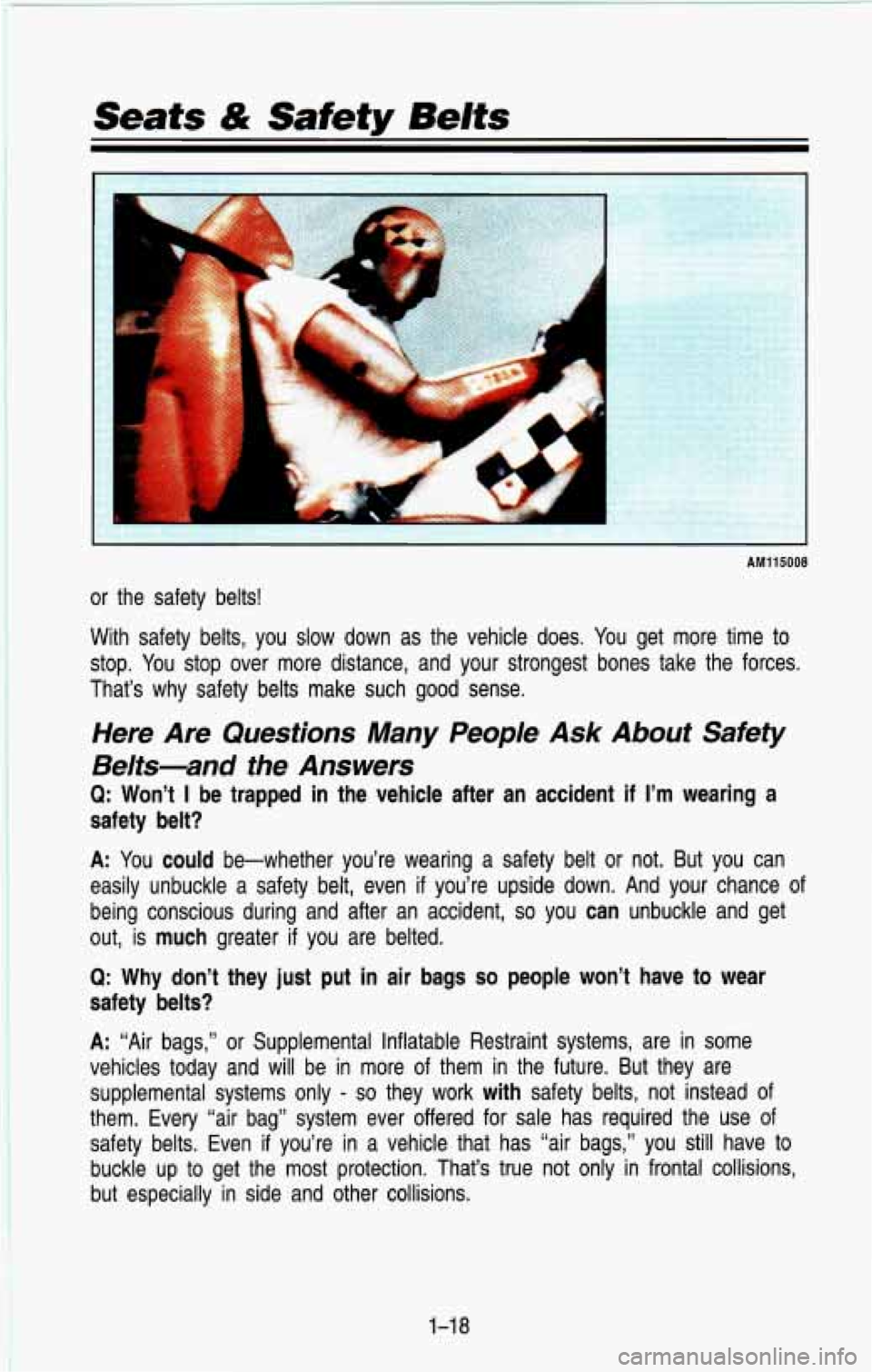
Seats & Safety Belts
1
AM115008
or the safety belts!
With safety belts, you slow down as the vehicle does. You get more time to
stop. You stop over more distance, and your strongest bones take the forces.
That’s why safety belts make such good sense.
Here Are Questions Many People Ask About Safety
Belts-and the Answers
Q: Won’t I be trapped in the vehicle after an accident if I’m wearing a
safety belt?
A: You could be-whether you’re wearing a safety belt or not. But you can
easily unbuckle a safety belt, even
if you’re upside down. And your chance of
being conscious during and after an accident,
so you can unbuckle and get
out, is
much greater if you are belted.
Q: Why don’t they just put in air bags so people won’t have to wear
safety belts?
A: “Air bags,” or Supplemental Inflatable Restraint systems, a\
re in some
vehicles today and
will be in more of them in the future. But they are
supplemental systems only
- so they work with safety belts, not instead of
them. Every “air bag” system ever offered for sale has r\
equired the use of
safety belts. Even if you’re in a vehicle that has “air bags,” you still have to
buckle up to get the most protection. That’s true not only in frontal collisions,
but especially in side and other collisions.
1-1 8
Page 69 of 386
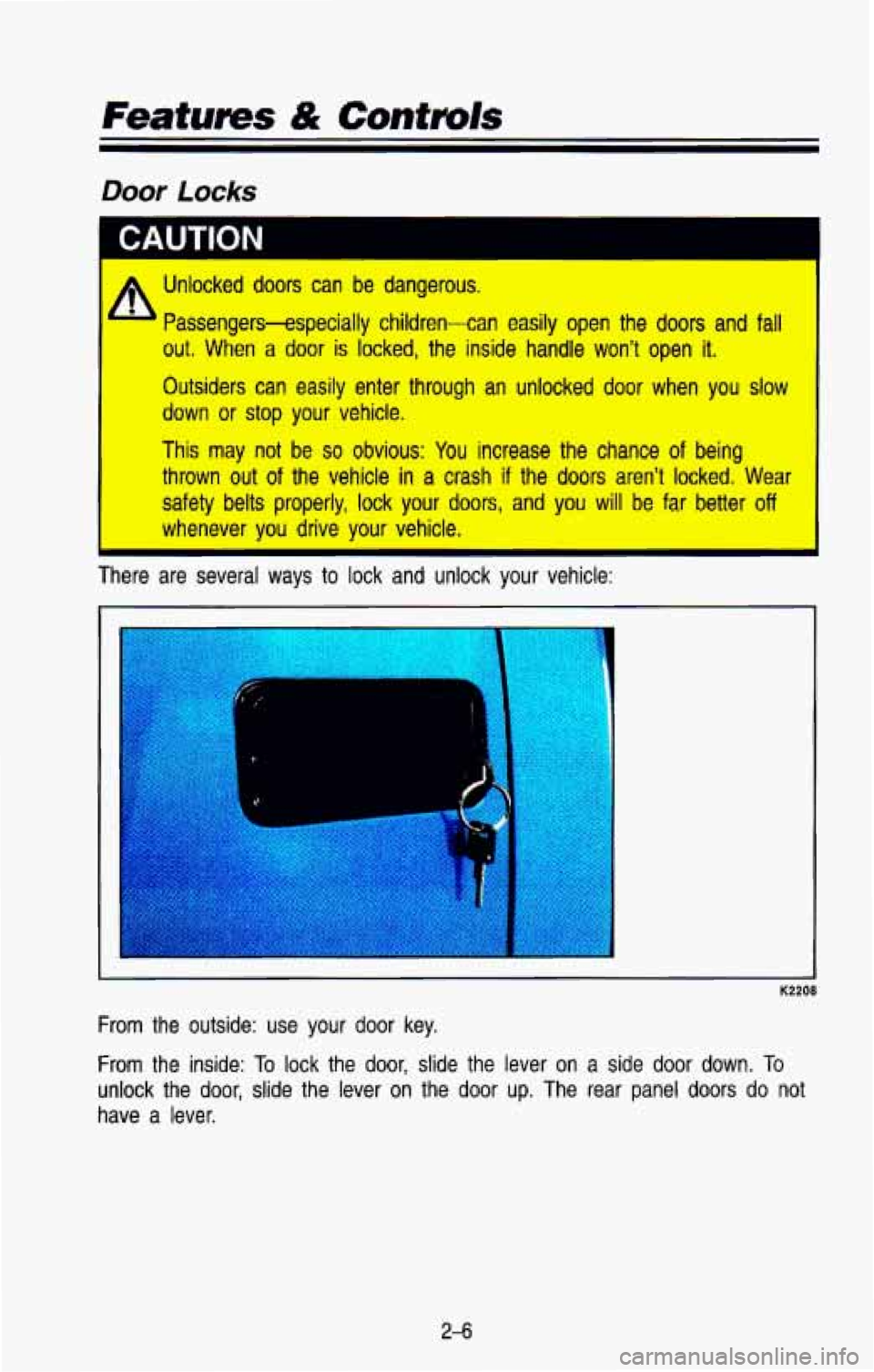
Featurns & Controls
A Unlocked doors can be dangerous. I
Passengers-especially children-can easily open the doors and fall
out. When a door is locked, the inside handle won’t open it.
Outsiders can easily enter through an unlocked door when you slow
This may not be so obvious: You increase the chance of being
thrown out
of the vehicle in a crash if the doors aren’t locked. Wear
safety belts properly, lock your doors, and you will be far better off
whenever you drive your vehicle. I
I down or stop your vehicle.
There are several ways to lock and unlock your vehicle:
From the outside: use your door key.
From the inside: To lock the door, slide the lever on a side door down. To
unlock the door, slide the lever on the door up. The rear pa\
nel doors do not
have a lever.
2-6
Page 73 of 386
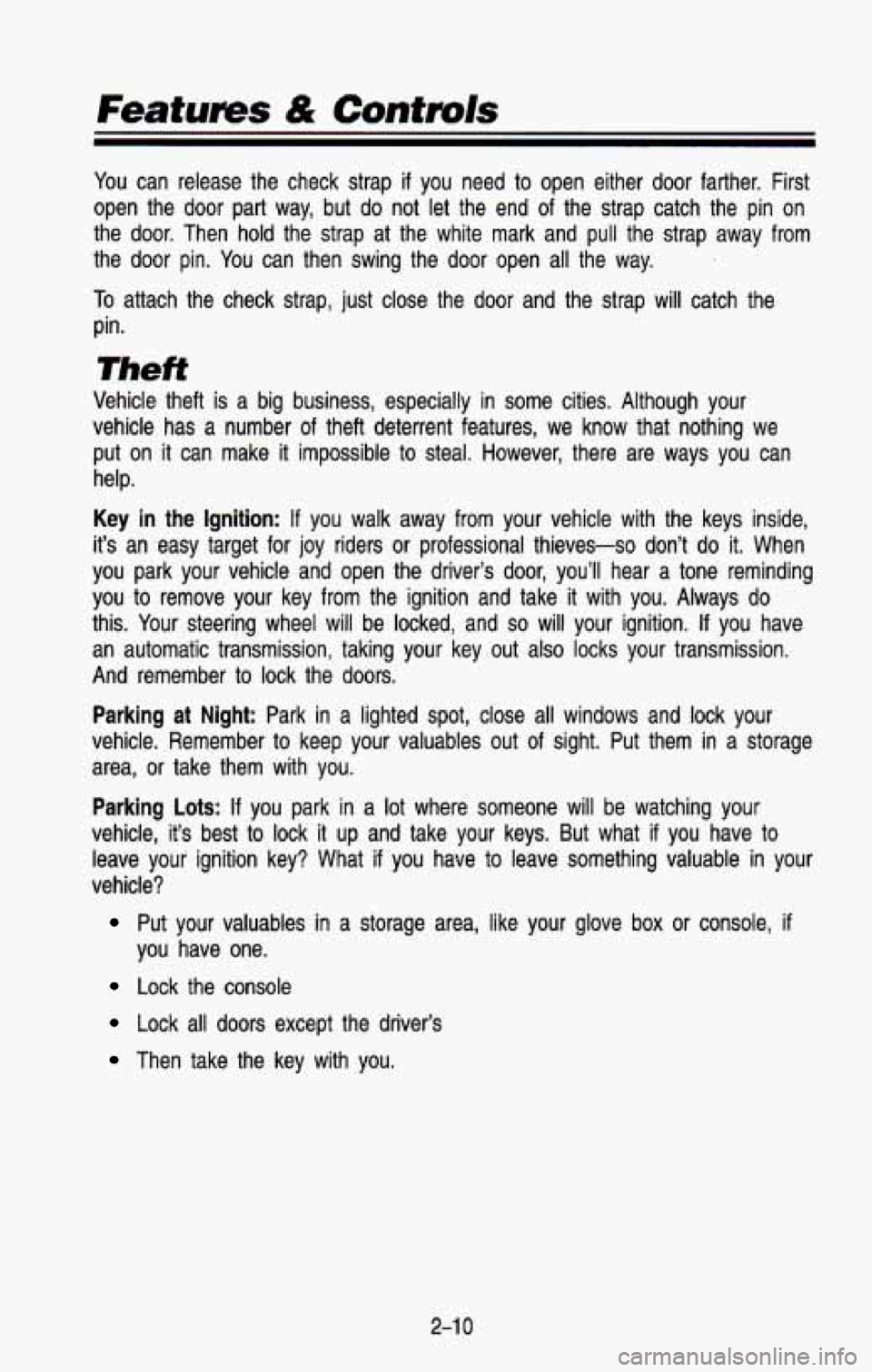
Features & Contmls
You can release the check strap if you need to open either door farther. First
open the door part way, but do not let the end of the strap catch the pin on
the
door. Then hold the strap at the white mark and pull the strap away from
the door pin. You can then swing the door open all the way.
To attach the check strap, just close the door and the strap wil\
l catch the
pin.
Theft
Vehicle theft is a big business, especially in some cities. Although your
vehicle has a number of theft deterrent features, we know that nothing we
put on it can make
it impossible to steal. However, there are ways you can
help.
Key in the Ignition: If you walk away from your vehicle with the keys inside,
it’s an easy target for joy riders or professional thieves-so don’t do it. When
you park
your vehicle and open the driver‘s door, you’ll hear a tone r\
eminding
you to remove your key from the ignition and take it with you. Always do
this. Your steering wheel will be locked, and
so will your ignition. If you have
an automatic transmission, taking your key out also locks your transmission.
And remember to lock the doors.
Parking at Night: Park in a lighted spot, close all windows and lock your
vehicle, Remember to keep your valuables out of sight. Put them
in a storage
area, or take them with you.
Parking Lots: If you park in a lot where someone will be watching your
vehicle, it’s best to lock it up and take your keys. But what
if you have to
leave your ignition key? What
if you have to leave something valuable in your
vehicle?
Put your valuables in a storage area, like your glove box or console, if
you have one.
Lock the console
Lock all doors except the driver’s
Then take the key with you.
2-1 0
Page 101 of 386
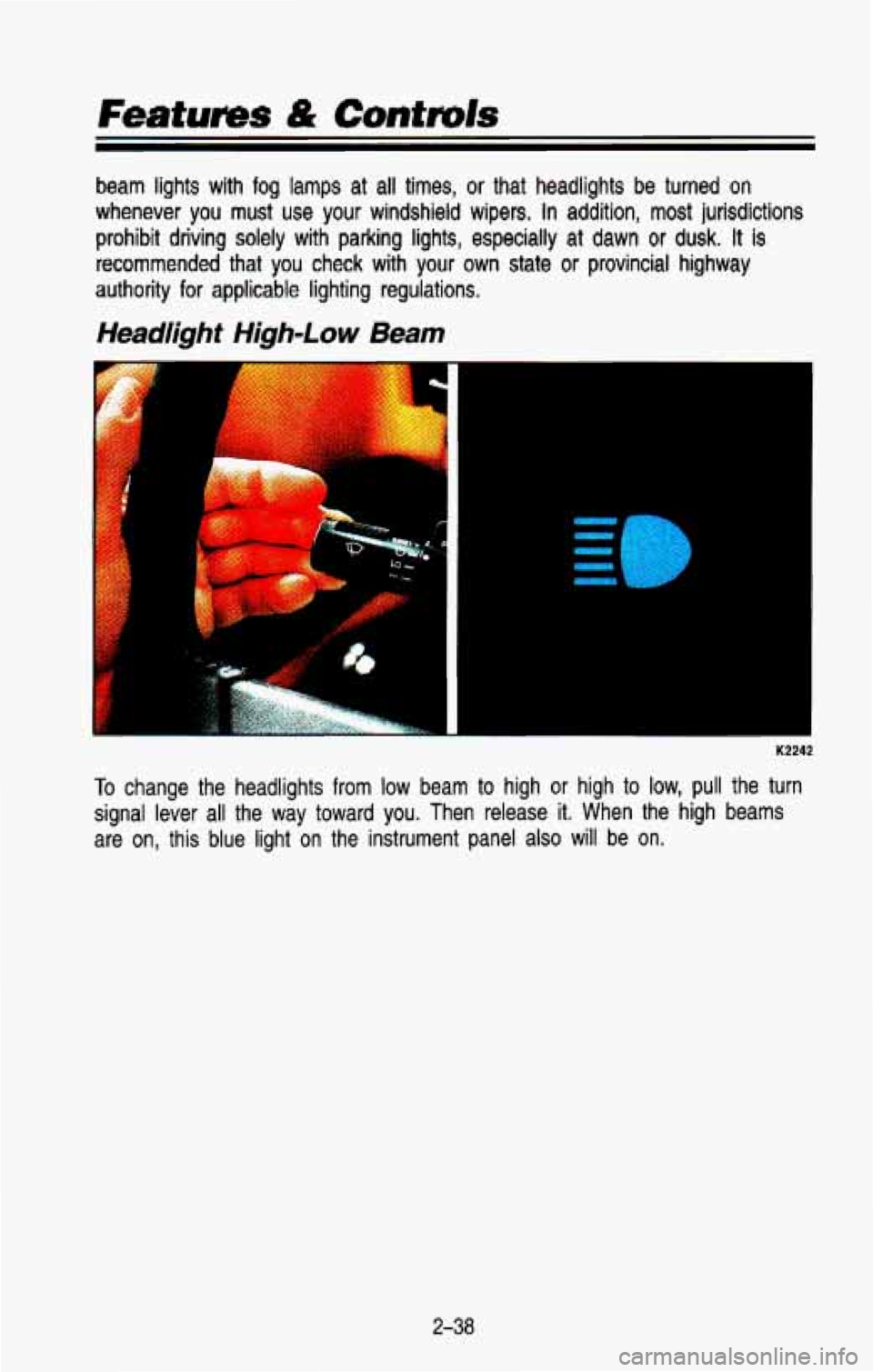
Features & Contmls
beam lights with fog lamps at all times, or that headlights be turned on
whenever you must use your windshield wipers. In addition, most jurisdictions
prohibit driving solely with parking lights, especially
at dawn or dusk. It is
recommended that you check with your own state or provincial h\
ighway
authority for applicable lighting regulations.
Head/ight Hiah-Low Beam
F. p h*' .- ..
K2242
To change the headlights from low beam to high or high to low, pull the turn
signal lever all the way toward you. Then release it. When the high beams
are on, this blue light on the instrument panel
also will be on.
2-38
Page 179 of 386
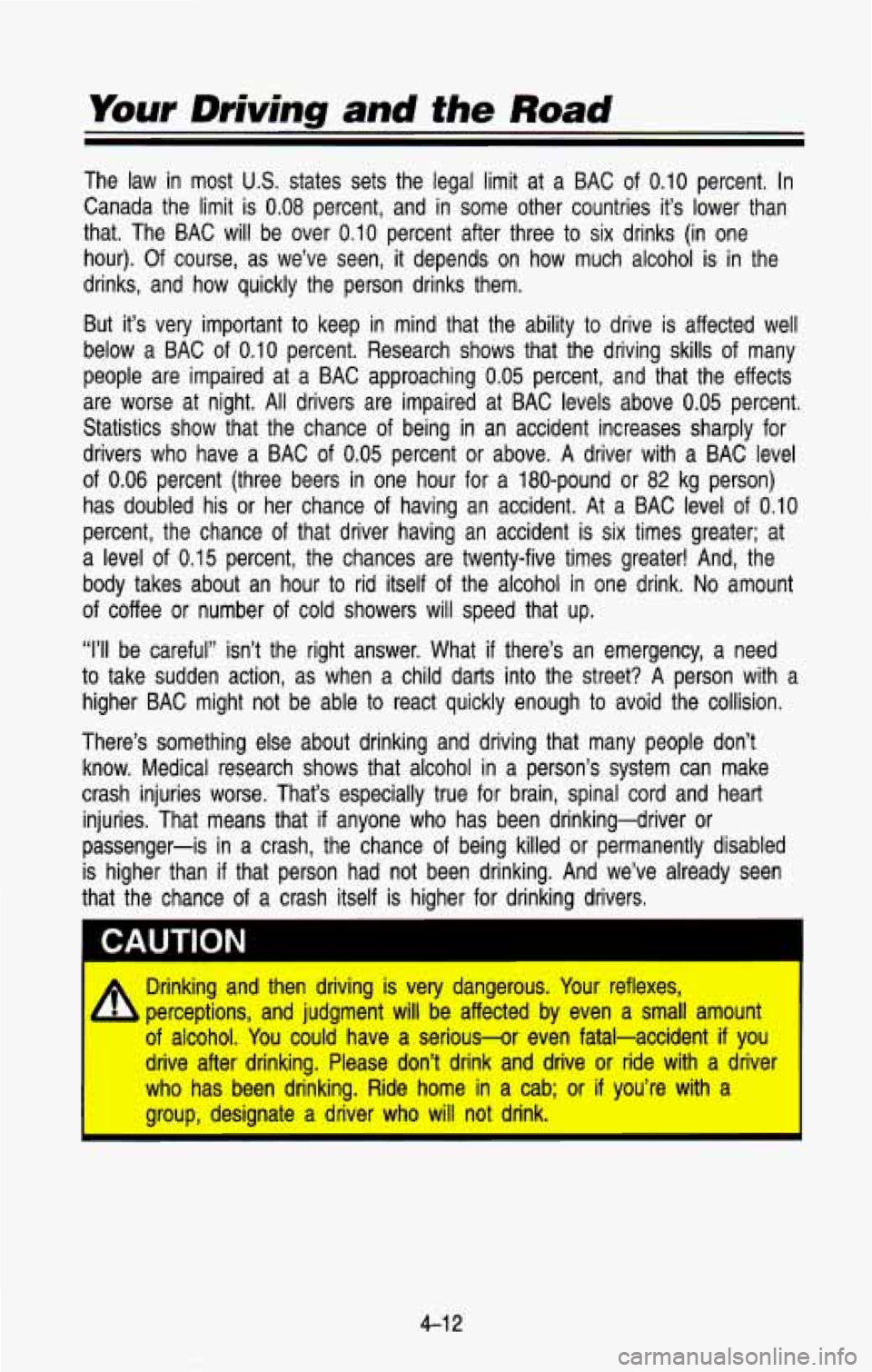
Your Driving and the Road
The law in most US. states sets the legal limit at a BAC of 0.10 percent. In
Canada the limit is
0.08 percent, and in some other countries it’s lower than
that. The BAC will be over
0.10 percent after three to six drinks (in one
hour). Of course, as we’ve seen,
it depends on how much alcohol is in the
drinks, and how quickly the person drinks them.
But it’s very important to keep in mind that the ability
to drive is affected well
below a BAC of
0.10 percent. Research shows that the driving skills of many
people are impaired at a BAC approaching
0.05 percent, and that the effects
are worse at night.
All drivers are impaired at BAC levels above 0.05 percent.
Statistics show that the chance
of being in an accident increases sharply for
drivers who have a BAC of
0.05 percent or above. A driver with a BAC level
of
0.06 percent (three beers in one hour for a 180-pound or 82 kg p\
erson)
has doubled his or her chance of having an accident.
At a BAC level of 0.10
percent, the chance of that driver having an accident is six times greater; at
a level
of 0.15 percent, the chances are twenty-five times greater! And, the
body takes about an hour
to rid itself of the alcohol in one drink. No amount
of coffee or number of cold showers will speed that up.
“I’ll be careful” isn’t the right answer. What if there’s an emergency, a need
to take sudden action, as when a child darts into the street? A person with a
higher BAC might not be able to react quickly enough
to avoid the collision.
There’s something else about drinking and driving that many \
people don’t know. Medical research shows that alcohol in a person’s syst\
em can make
crash injuries worse. That’s especially true for brain, spina\
l cord and heart
injuries. That means that
if anyone who has been drinking-driver or
passenger-is in a crash, the chance of being killed or permanently disabled
is higher than
if that person had not been drinking. And we’ve already seen
that the chance of a crash itself is higher for drinking drivers.
I CAUTION
Drinking and then driving is very dangerous. Your reflexes,
L perceptions, and judgment will be affected by even a small amount
of alcohol. You could have a serious-or even fatal-accident if you
drive after drinking. Please don’t drink and drive
or ride with a driver
who has been drinking. Ride home in a cab; or if you’re with a
I group, designate a driver who will not drink.
4-1 2
Page 189 of 386
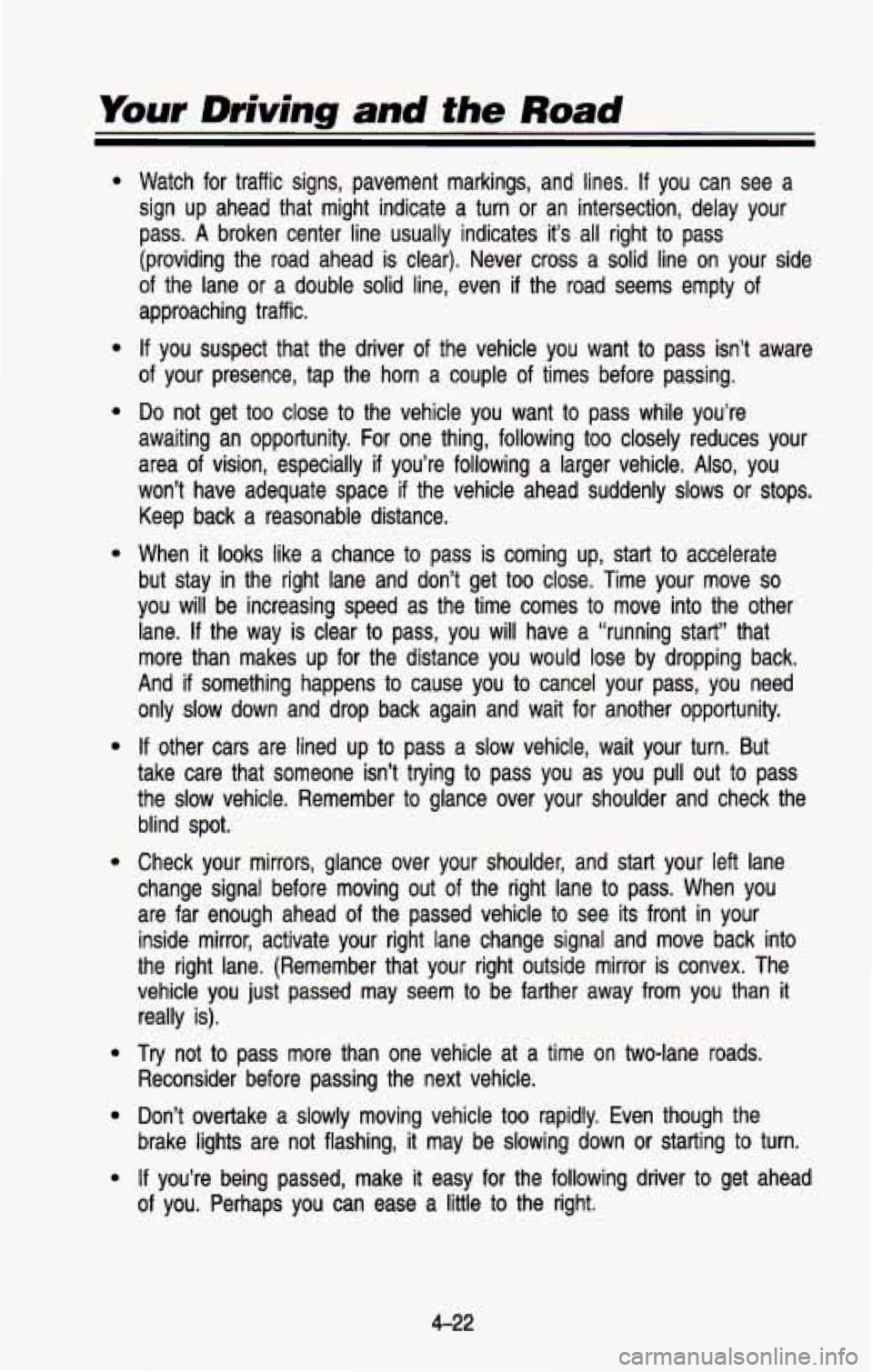
Your Driving and the Road
Watch for traffic signs, pavement markings, and lines. If you can see a
sign up ahead that might indicate a turn
or an intersection, delay your
pass.
A broken center line usually indicates it’s all right to pass
(providing the road ahead is clear). Never cross a solid lin\
e on your side
of the lane
or a double solid line, even if the road seems empty of
approaching traffic.
If you suspect that the driver of the vehicle you want to pass isn’t aware
of your presence, tap the horn a couple of times before passi\
ng.
Do not get too close to the vehicle you want to pass while you’re
awaiting an opportunity.
For one thing, following too closely reduces your
area
of vision, especially if you’re following a larger vehicle. Also, you
won’t have adequate space
if the vehicle ahead suddenly slows or stops.
Keep back a reasonable distance.
When it looks like a chance
to pass is coming up, start to accelerate
but stay in the right lane and don’t get too close. Time your move
so
you will be increasing speed as the time comes to move into the other
lane.
If the way is clear to pass, you will have a “running start” that
more than makes up for the distance you would lose by dropping back.
And
if something happens to cause you to cancel your pass, you need
only slow down and drop back again and wait for another opportunity.
If other cars are lined up to pass a slow vehicle, wait your turn. But
take care that someone isn’t trying
to pass you as you pull out to pass
the
slow vehicle. Remember to glance over your shoulder and check the
blind spot.
Check your mirrors, glance over your shoulder, and start your
left lane
change signal before moving out of the right lane to pass. When you
are far enough ahead of the passed vehicle to see its front in your
inside mirror, activate your right lane change signal and move \
back into
the right lane. (Remember that your right outside mirror is convex. The
vehicle
you just passed may seem to be farther away from you than it
really is).
Try not to pass more than one vehicle at a time on two-lane roads.
Reconsider before passing the next vehicle.
Don’t overtake a slowly moving vehicle too rapidly. Even tho\
ugh the
brake lights are not flashing,
it may be slowing down or starting to turn.
If you’re being passed, make it easy for the following driver to get ahead
of you. Perhaps you can ease a little to the right.
4-22
Page 190 of 386
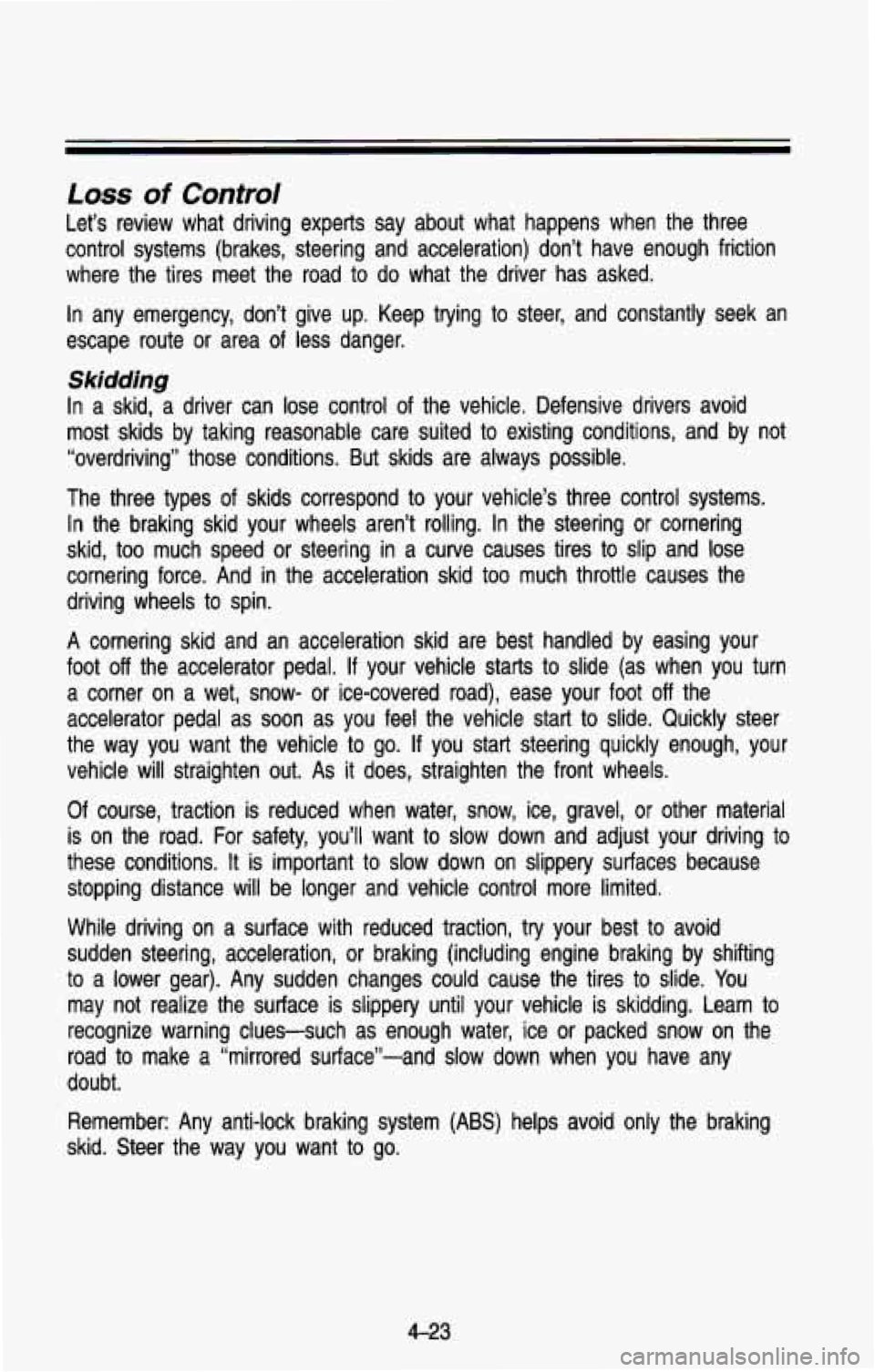
Loss of Control
Let’s review what driving experts say about what happens whe\
n the three
control systems (brakes, steering and acceleration) don’t ha\
ve enough friction
where the tires meet the road to do what the driver has asked.
In any emergency, don’t give up. Keep trying
to steer, and constantly seek an
escape route or area of less danger.
Skidding
In a skid, a driver can lose control of the vehicle. Defensive d\
rivers avoid
most skids by taking reasonable care suited
to existing conditions, and by not
“overdriving” those conditions. But skids are always possib\
le.
The three types of skids correspond
to your vehicle’s three control systems.
In the braking skid your wheels aren’t rolling. In the steering
or cornering
skid,
too much speed or steering in a curve causes tires to slip and lose
cornering force. And in the acceleration skid too much throttle causes the
driving wheels to spin.
A cornering skid and an acceleration skid are best handled by easing your
foot off the accelerator pedal. If your vehicle starts to slide (as when you turn
a corner on a wet, snow-
or ice-covered road), ease your foot off the
accelerator pedal as soon as you feel the vehicle start
to slide. Quickly steer
the way you want the vehicle
to go. If you start steering quickly enough, your
vehicle will straighten out. As it does, straighten the front wheels.
Of course, traction is reduced when water, snow, ice, gravel,
or other material
is on the road.
For safety, you’ll want to slow down and adjust your driving to
these conditions.
It is important to slow down on slippery surfaces because
stopping distance will be longer and vehicle control more limit\
ed.
While driving on a surface with reduced traction,
try your best to avoid
sudden steering, acceleration,
or braking (including engine braking by shifting
to a lower gear). Any sudden changes could cause the tires t\
o slide. You
may not realize the surface is slippery until your vehicle is \
skidding. Learn to
recognize warning clues-such as enough water, ice or packed snow on the
road to make a “mirrored surface”-and slow down when you have any\
doubt.
Remember: Any anti-lock braking system (ABS) helps avoid only the braking
skid. Steer the way you want
to go.
4-23
Page 192 of 386
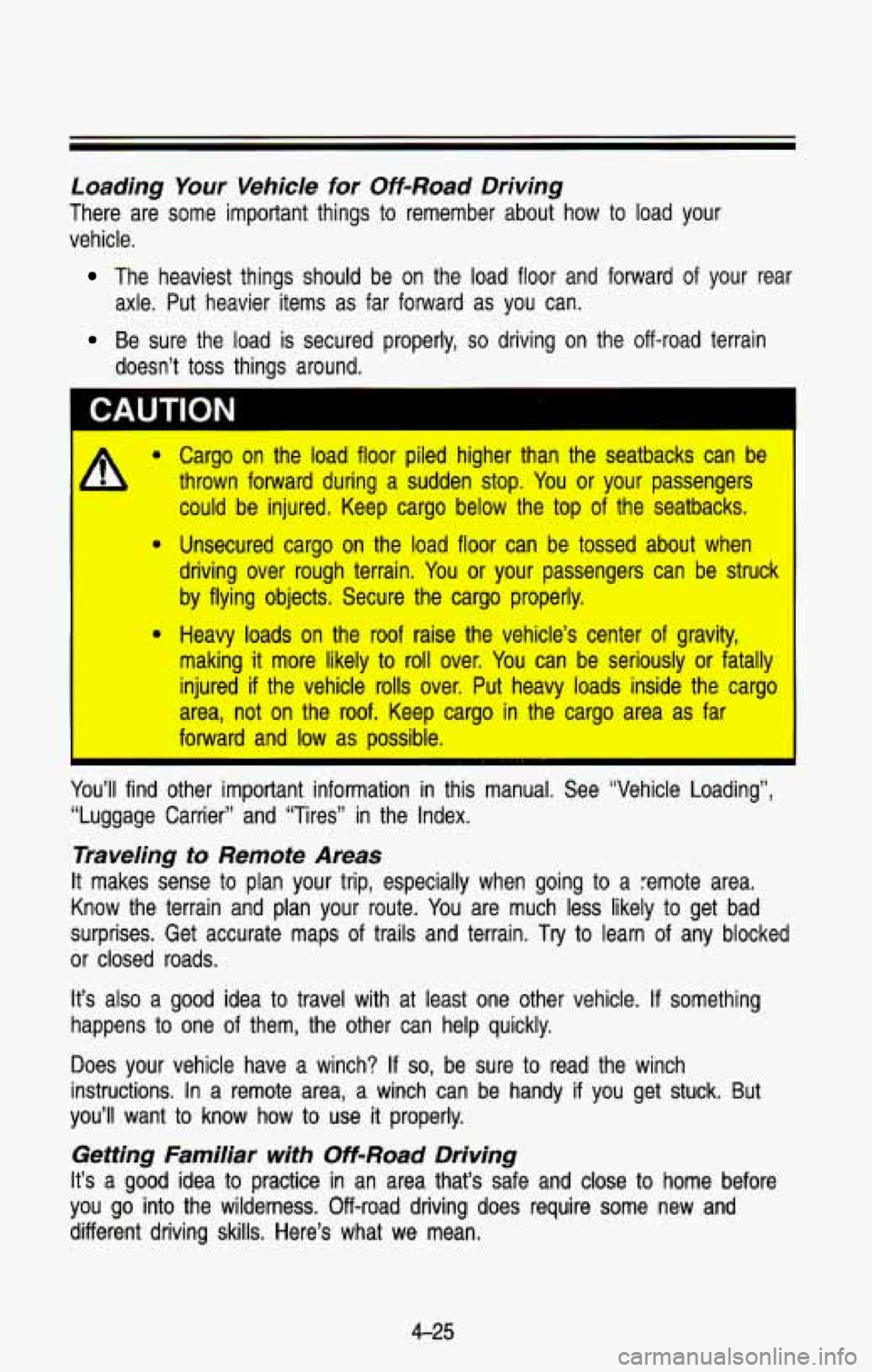
Loading Your Vehicle for Off-Road Driving
There are some important things to remember about how to load \
your
vehicle.
The heaviest things should be on the load floor and forward of your rear
axle. Put heavier items as far forward as you can.
Be sure the load is secured properly, so driving on the off-road terrain
doesn’t toss things around.
rn CAUTION
m m
Cargo on the load floor piled higher than the seatbacks can be
thrown forward during
a sudden stop. You or your passengers
could
be injured. Keep cargo below the top of the seatbacks.
Unsecured
cargo on the load floor can be tossed about when
driving over rough terrain.
You or your passengers can be struck
by flying objects. Secure the cargo properly.
Heavy loads on the roof raise the vehicle’s center
of gravity,
making
.it more likely to roll over. You can be seriously or fatally
injured
if the vehicle rolls over. Put heavy loads inside the cargo
area, not on the roof. Keep
cargo in the cargo area as far
forward and
low as possible. I
You’ll find other important information in this manual. See “Vehicle Loading”,
“Luggage Carrier” and “Tires” in the Index.
Traveling to Remote Areas
It makes sense to plan your trip, especially when going to a \
:emote area.
Know the terrain and plan your route. You are much less likely
to get bad
surprises. Get accurate maps of trails and terrain.
Try to learn of any blocked
or closed roads.
It‘s also a good idea to travel with at least one other vehicle. If something
happens to one of them, the other can help quickly.
Does your vehicle have a winch?
If so, be sure to read the winch
instructions. In a remote area,
a winch can be handy if you get stuck. But
you’ll want to know how to use it properly.
Getting Familiar with Off-Road Driving
It’s a good idea to practice in an area that’s safe and close to home befor\
e
you go into the wilderness. Off-road driving does require some \
new and
different driving skills. Here’s what
we mean.
4-25